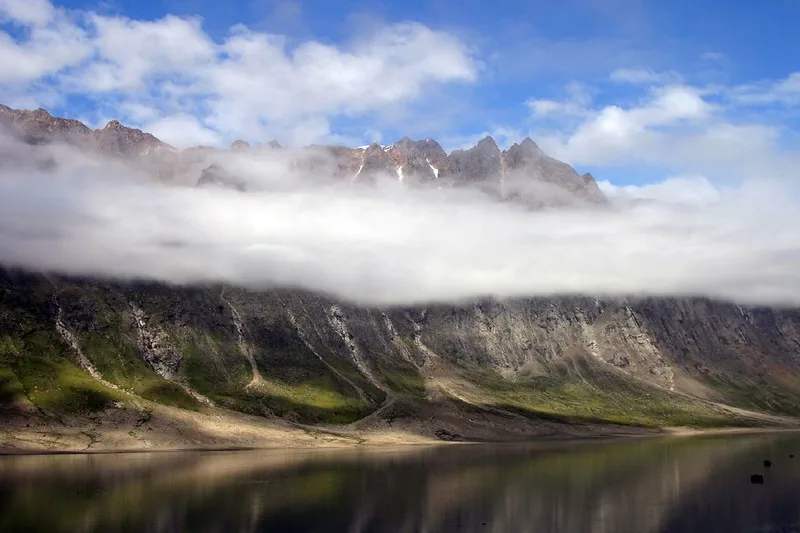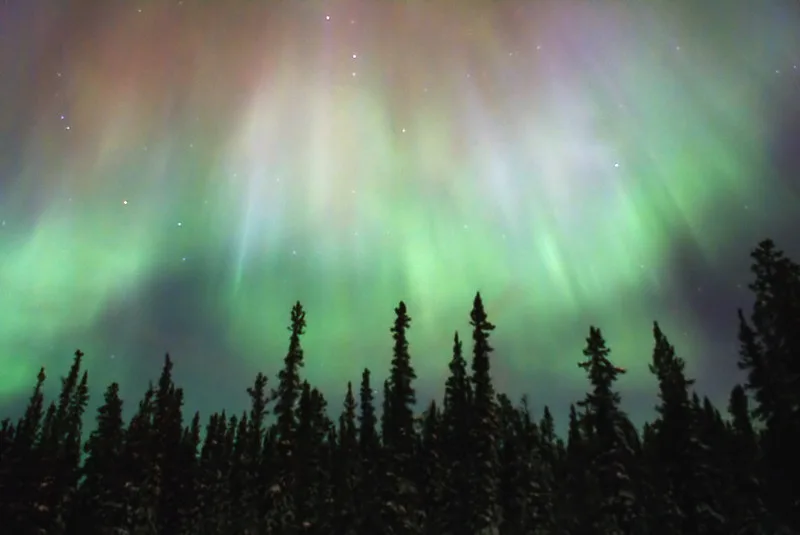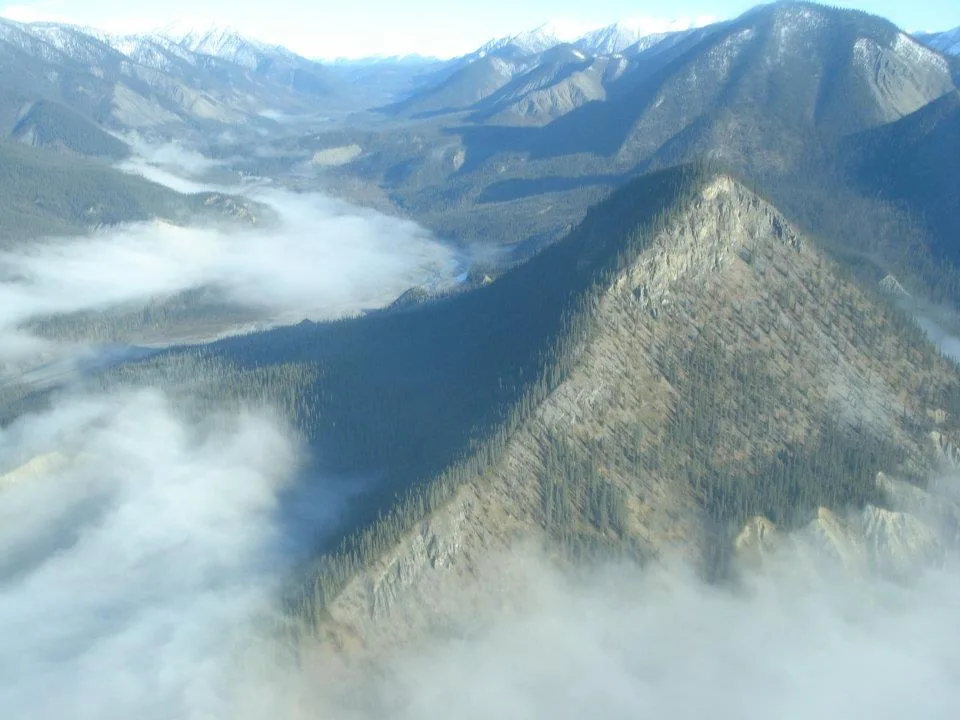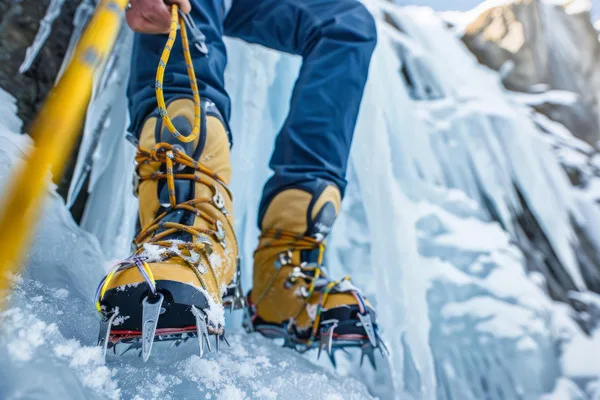Are you ready to embark on an adventure of a lifetime? Imagine a place where the landscapes are untouched, the air is crisp, and the beauty is beyond anything you’ve ever seen. Welcome to Canada’s Arctic and Northern Territories, a hiker’s paradise.
From towering mountain peaks to vast tundras, these regions offer some of the most stunning and unique hiking experiences on the planet. Whether you’re drawn to the magical summer light where the sun never sets, or the enchanting Northern Lights dancing in the winter sky, there’s something here for every nature lover.

Author : Rick Derevan – flickr.com
Picture yourself standing at the base of Mount Thor in Auyuittuq National Park, gazing up at the world’s tallest vertical cliff. Imagine hiking through the vibrant autumn colors of Tombstone Territorial Park, or exploring the deep canyons and waterfalls of Nahanni National Park Reserve. These adventures are waiting for you, promising unforgettable memories and breathtaking views.
Ready to explore the unparalleled beauty of Canada’s Arctic and Northern Territories?
The Allure of the Arctic and Northern Territories
Stunning Landscapes and Natural Beauty
Canada’s Arctic and Northern Territories offer some of the most breathtaking views you can imagine. Picture vast stretches of ice and snow, tall mountain ranges, and clear lakes that reflect the sky perfectly. The land, shaped by glaciers and rivers, has dramatic valleys and rugged terrains. In summer, the sun never sets, creating a magical golden light. In winter, the Northern Lights put on a colorful show in the night sky, leaving everyone amazed.
The landscape changes with each season. Spring and summer reveal green tundra with colorful wildflowers. Autumn paints the trees in bright red and orange. Winter covers everything in snow, turning it into a peaceful, white wonderland. This constantly changing scenery shows the true beauty and power of nature.

Аuthor : Studiolit – flickr.com
Unique Plants and Animals
The Arctic and Northern Territories are home to unique plants and animals that have adapted to the extreme conditions. You’ll find tough plants like Arctic willows, dwarf birches, and various mosses and lichens. In the short summer, wildflowers like Arctic poppies and saxifrages bloom, adding color to the tundra.
The wildlife is just as special. Polar bears, Arctic foxes, and caribou roam the land. These animals have thick fur and special behaviors to survive the cold. The coastal waters are full of life too, with seals, whales, and walruses often seen. Birdwatchers can spot snowy owls, gyrfalcons, and many migratory birds during the warmer months.
Each plant and animal plays an important role in this delicate ecosystem. They aren’t just surviving; they are thriving and contributing to a balanced natural world.
The Pristine Wilderness
One of the best reasons to hike in these regions is the feeling of being in a truly untouched wilderness. These areas are mostly undeveloped and free from human interference. Here, you can experience nature in its purest form, away from the noise and stress of city life.
The isolation means hikers often have the trails to themselves, enjoying peace and solitude. The only sounds are from wildlife and the wind. This untouched wilderness offers a sanctuary for those wanting a deep connection with nature.
Preserving these landscapes is vital for our planet’s health. The Arctic helps regulate global temperatures and weather patterns. By exploring and appreciating these areas, we also support their protection, ensuring future generations can enjoy their beauty and diversity.
Popular Hiking Destinations
Auyuittuq National Park: Highlights, Trails, and Tips
Auyuittuq National Park, located on Baffin Island in Nunavut, is a paradise for adventurous hikers. The name Auyuittuq means “the land that never melts,” and it perfectly describes this icy wonderland. The park is famous for its stunning fjords, towering peaks, and glaciers.
Highlights: One of the most iconic features of the park is Mount Thor, which has the world’s tallest vertical cliff. Another highlight is the Akshayuk Pass, a traditional Inuit travel route that offers breathtaking views of glaciers, mountains, and valleys.
Trails: The Akshayuk Pass Trail is the most popular route in the park. It is a challenging 97-kilometer trek that takes about 8 to 10 days to complete. The trail offers a mix of terrain, including rocky paths, river crossings, and glacial moraines. Hikers should be prepared for cold temperatures, even in summer.
Tips: Before heading out, make sure you have all the necessary permits and register with the park authorities. Bring warm clothing, sturdy hiking boots, and enough food supplies. Weather can change quickly, so always be prepared for sudden storms. It’s also important to respect the local wildlife and keep a safe distance from animals like polar bears.
Tombstone Territorial Park: Highlights, Trails, and Tips
Tombstone Territorial Park in Yukon is known for its dramatic landscapes and diverse wildlife. The park’s rugged peaks and alpine meadows are a hiker’s dream. It offers some of the best hiking experiences in Canada’s north.
Highlights: The park is named after the Tombstone Mountain, which has a distinctive, jagged appearance. The park is also home to a variety of wildlife, including moose, caribou, and grizzly bears. In autumn, the landscape transforms into a vibrant tapestry of fall colors, making it a perfect time for hiking.
Trails: One of the most popular trails is the Grizzly Lake Trail. This 22-kilometer round-trip hike takes you through stunning scenery, including alpine lakes and towering mountains. For those looking for a longer adventure, the multi-day Tombstone Range Trek offers a challenging but rewarding experience.
Tips: Plan your trip well in advance, especially if you’re visiting during the peak season. The weather can be unpredictable, so pack layers of clothing to stay warm and dry. Make sure to carry bear spray and know how to use it. Staying on designated trails helps protect the delicate ecosystem and ensures a safe hike.
Nahanni National Park Reserve: Highlights, Trails, and Tips
Nahanni National Park Reserve, located in the Northwest Territories, is a UNESCO World Heritage Site renowned for its spectacular landscapes and rich biodiversity. The park is named after the South Nahanni River, which flows through deep canyons and over powerful waterfalls.
Highlights: One of the park’s main attractions is the Virginia Falls, which is twice the height of Niagara Falls. The Cirque of the Unclimbables is another highlight, offering stunning views of towering granite spires. The park is also home to diverse wildlife, including Dall’s sheep, mountain goats, and wolves.
Trails: The Sunblood Mountain Trail is a popular day hike that offers panoramic views of the park. For a more challenging adventure, the multi-day Nahanni River trip allows you to explore the park by boat and on foot, combining hiking with river paddling. The challenging Rabbitkettle Lake Trail leads to the unique tufa mounds, formed by mineral springs.
Tips: Due to the remote location, it’s essential to be well-prepared. Bring a detailed map, a compass, and a GPS device. Weather conditions can change rapidly, so pack appropriate gear for rain and cold temperatures. Register your trip with park authorities and ensure you have the necessary permits. Respect the natural environment and leave no trace of your visit.

Аuthor : Fort Simpson Chamber of Commerce – wikimedia.org
Preparing for the Adventure
Essential Gear for Arctic and Northern Hikes
Hiking in the Arctic and Northern Territories requires special gear to handle the extreme conditions. Here are some essentials:
- Clothing: Layering is key. Start with a base layer that keeps sweat away from your skin. Add an insulating layer, like a fleece or down jacket, to keep you warm. Finish with a waterproof and windproof outer layer to protect you from the elements. Don’t forget a warm hat, gloves, and thermal socks.
- Footwear: Sturdy, waterproof hiking boots with good ankle support are essential. Make sure they are well broken in to avoid blisters. Gaiters can help keep snow and debris out of your boots.
- Backpack: A durable, weather-resistant backpack with a capacity of 40-60 liters is ideal for multi-day hikes. It should have comfortable straps and a hip belt to distribute the weight evenly.
- Navigation Tools: A detailed map of the area, a compass, and a GPS device are crucial for navigating the remote and often unmarked trails. Make sure you know how to use them.
- Camping Gear: A high-quality, four-season tent will protect you from the harsh weather. A warm sleeping bag rated for sub-zero temperatures and a sleeping pad for insulation from the cold ground are also important.
- Food and Water: Pack lightweight, high-energy foods that are easy to prepare. Always carry more food than you think you’ll need. A portable stove and cooking utensils are useful for preparing meals. Bring a water filter or purification tablets to ensure you have access to safe drinking water.
- Other Essentials: A first aid kit, headlamp with extra batteries, multi-tool, fire-starting kit, sunscreen, and insect repellent are all necessary items for a safe and comfortable hike.

Importance of Physical Fitness and Training
Hiking in the Arctic and Northern Territories is physically demanding, so it’s important to be in good shape before you go. Here are some tips to prepare your body:
- Cardiovascular Fitness: Engage in regular cardiovascular exercises such as running, cycling, or swimming. These activities improve your endurance and help you handle long days of hiking.
- Strength Training: Strengthen your muscles, especially your legs, back, and core. Exercises like squats, lunges, and deadlifts are beneficial. Strong muscles help you carry a heavy backpack and navigate challenging terrain.
- Hiking Practice: Try to go on local hikes with a loaded backpack to simulate the conditions you’ll face. This helps you get used to the weight and builds your hiking-specific muscles.
- Flexibility and Balance: Incorporate stretching and balance exercises into your routine. Yoga and Pilates are great for improving flexibility and core strength, which can help prevent injuries.
Start your training at least a few months before your trip to give your body ample time to adapt. Consistency is key, so make sure to maintain a regular exercise schedule.
Safety Tips and Guidelines
Safety is paramount when hiking in remote and extreme environments. Here are some important tips and guidelines to keep you safe:
- Plan Ahead: Research the area thoroughly and understand the route you will be taking. Know the distance, elevation changes, and potential hazards. Check the weather forecast and be prepared for sudden changes.
- Inform Others: Always let someone know your itinerary, including your planned route and expected return time. Check in with them regularly if possible.
- Travel in Groups: It’s safer to hike with a group, especially in remote areas. If you must hike alone, be extra cautious and well-prepared.
- Stay on Marked Trails: Stick to marked trails to avoid getting lost and to minimize your impact on the environment. Use your map and compass regularly to ensure you are on the right path.
- Be Bear Aware: Carry bear spray and know how to use it. Make noise while hiking to avoid surprising wildlife. Store food securely and away from your sleeping area.
- Stay Hydrated and Nourished: Drink plenty of water and eat regular meals and snacks to keep your energy levels up. Dehydration and low energy can impair your judgment and physical abilities.
- Avoid Hypothermia and Frostbite: Dress in layers and stay dry to prevent hypothermia. Protect exposed skin from frostbite by wearing gloves, a hat, and face protection in extreme cold.
- Emergency Preparedness: Carry a basic first aid kit and know how to use it. An emergency shelter, such as a bivy sack, can be a lifesaver if you get caught in bad weather. A satellite phone or personal locator beacon can help you call for help in an emergency.
By being well-prepared and following these safety guidelines, you can enjoy a safe and memorable hiking adventure in the Arctic and Northern Territories.
Conclusion
Canada’s Arctic and Northern Territories offer breathtaking landscapes and unique wildlife. Auyuittuq, Tombstone, and Nahanni National Parks provide diverse and stunning hiking experiences. Essential gear, proper physical fitness, and preparation are crucial for a successful hike. Safety guidelines, including planning ahead and being bear aware, are vital for hiking in remote areas. Exploring these regions supports environmental preservation and offers a deep connection with nature.
FAQs
What is the best time of year to hike in Canada’s Arctic and Northern Territories?
The best time to hike in these regions is during the summer months, from June to August. During this period, temperatures are milder, and the daylight lasts longer, providing better hiking conditions and safety.
Do I need a permit to hike in these national parks?
Yes, most national parks in Canada’s Arctic and Northern Territories require permits for hiking and camping. It’s important to check with the specific park’s regulations and obtain the necessary permits before your trip.
What kind of wildlife can I expect to see?
You may encounter a variety of wildlife, including polar bears, Arctic foxes, caribou, moose, and grizzly bears. Birdwatchers can also spot species such as snowy owls and gyrfalcons. Always observe wildlife from a safe distance.
How should I prepare for the cold weather?
Dress in layers to manage the varying temperatures and conditions. Essential clothing includes a moisture-wicking base layer, insulating mid-layers, and a waterproof and windproof outer layer. Don’t forget warm gloves, a hat, and thermal socks.
What safety precautions should I take while hiking?
Plan your route in advance, inform someone about your itinerary, carry bear spray, and stay on marked trails. Bring a map, compass, and GPS device. Ensure you have a first aid kit and know how to use it. It’s also crucial to be prepared for sudden weather changes.
Can I hike alone, or is it better to go with a group?
While it is possible to hike alone, it is safer to hike with a group, especially in remote areas. If you choose to hike alone, make sure you are well-prepared and take extra precautions to ensure your safety.